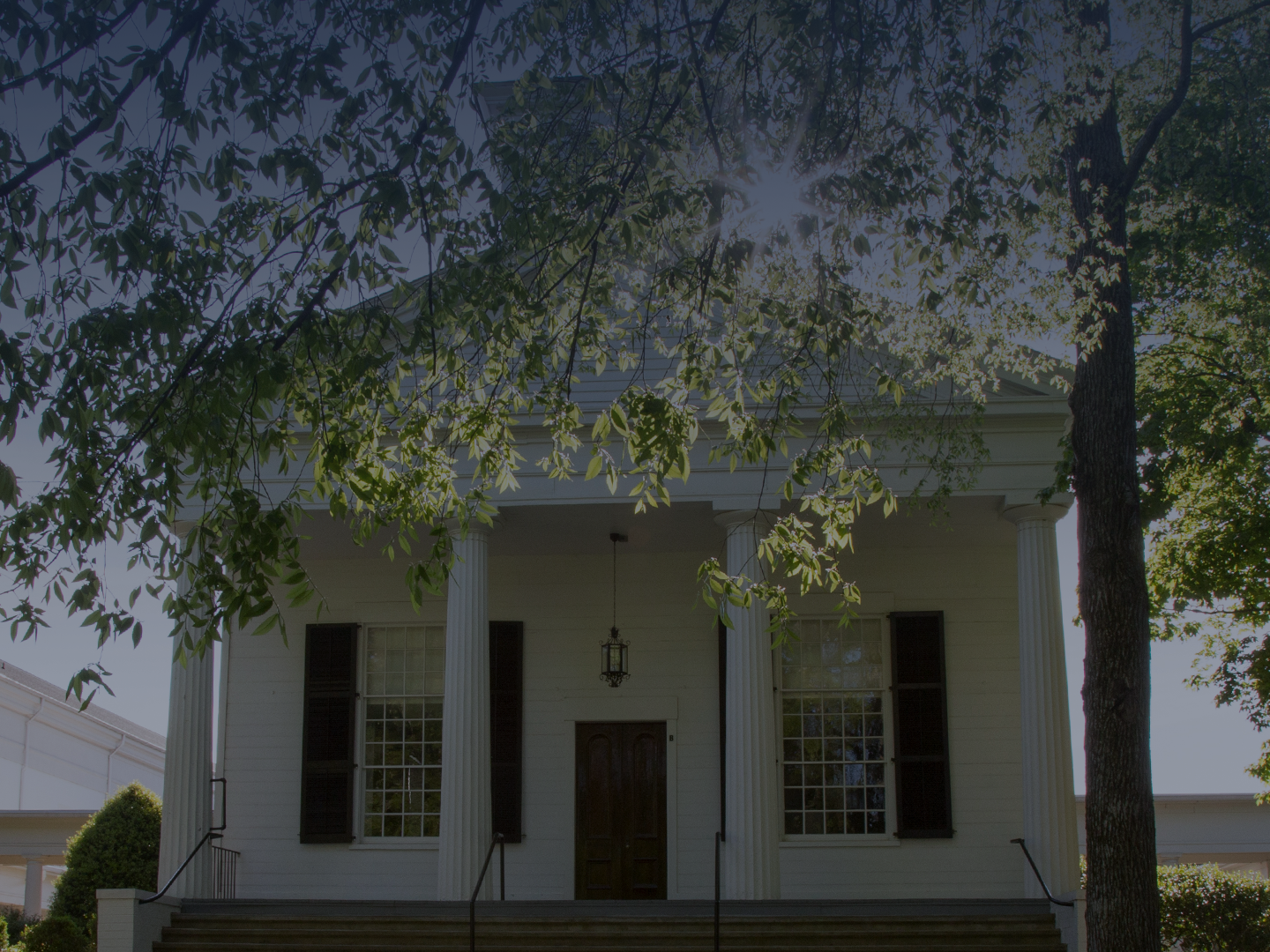Established in 1839
Roswell Presbyterian Church was established in 1839 and is a congregation of the Presbyterian Church (U.S.A.) within the Presbytery of Greater Atlanta. Since our formation, we have been a church dedicated to reaching out in love and service to the community and the world.
We are a congregation with deep historic roots, and our Historic Sanctuary and History Room stand as symbols of our gratitude for those who have come before us. It is because of the dedication and commitment of those who preceded us that we are able to be a vibrant community today.
The Church Beginnings
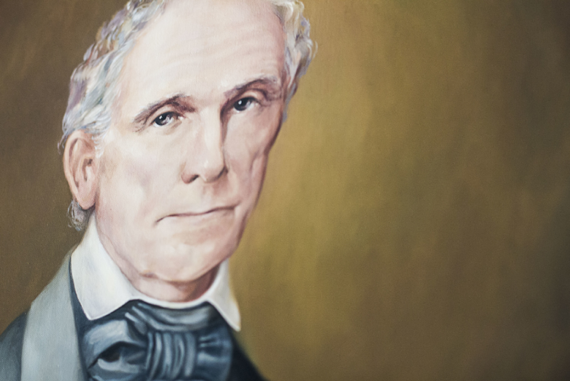
A portrait of Rev. Nathaniel Pratt which hangs in the church narthex.
In 1838, Roswell King, founder of the city of Roswell, and his son, Barrington, invited friends and relatives living on the Georgia coast to Roswell to begin a new life on the Georgia frontier. The following year, they invited the Reverend Nathaniel Alpheus Pratt, pastor of the First Presbyterian Church of Darien, to become their pastor and to organize a Presbyterian church.
On October 20, 1839, while visiting in Roswell, the Reverend Pratt met with the Presbyterian organizing group. The meeting was held in Primrose Cottage, the home of Mrs. Eliza King Hand, widowed daughter of Roswell King. Services were held at Mrs. Hand’s home until a church could be built. Original members were Mr. John Dunwody (in later years, spelled “Dunwoody”), Mrs. Jane Dunwody, Miss Marion Dunwody, Mr. James S. Bulloch, Mrs. Martha Bulloch, Miss Susan Elliott, Mr. Barrington King, Mrs. Catherine King, Mrs. Eliza Hand, Mrs. Elizabeth Hand, Mr. Archibald Smith, Mrs. Anne Smith, Miss Elizabeth Magill, Miss Helen Magill, and Miss Sarah Gould. Mr. John Dunwody, Mr. Barrington King, and Mr. Archibald Smith were elected and installed as elders. Two children, Charles Irvine Bulloch and John Bayard Hand, were baptized.
The Reverend Pratt and his wife Catherine Barrington King (daughter of Roswell King) and their children arrived in Roswell on May 15, 1840. On Sunday, May 17, he assumed his duties as pastor, a position he filled with humility and distinction for 39 years.
The Early Years
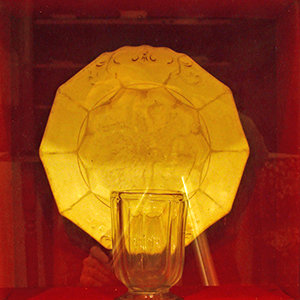
Communion Cup and Plate used in our first communion service on October 23, 1839, at Primrose Cottage
The church was incorporated on December 23, 1840. The town was incorporated in 1854, with boundaries designated as a one-mile radius from the church, the heart of the town. The Academy, the town’s first school, was adjacent to and operated by the church, with Dr. Pratt as director. In 1870 the church deeded the school to the town. VIEW MAP
Master craftsman Willis Ball of Windsor, Connecticut, the town in which Roswell King was born, built the Doric-columned church and homes of the original families. Dr. Pratt also was born in Connecticut, in Saybrook County in 1796, later coming south to work as a missionary on the Georgia-Florida frontier.
Roswell Presbyterian Church was built similar in design to that of the New England meetinghouse. It was very much like the Midway Congregational Church on the Georgia coast, where many of the early Roswell families and their ancestors were members. Both churches had box pews, raised pulpits, and galleries for slave members.
The short, square bell tower of the Roswell church holds an iron ship bell cast in Philadelphia in 1827. The bell was presented to the church by members of the Independent Church of Savannah. It is still rung for weddings and funerals.
Dr. Pratt graduated from Yale College and Princeton Theological Seminary. He was one of the founders of the Cherokee Presbytery in North Georgia in 1844 and the Synod of Georgia the following year. He was elected Moderator of the Synod in 1849 and received the honorary degree of Doctor of Divinity from Oglethorpe University at Milledgeville in 1854.
The people of Roswell would never forget the year 1853. On December 23 of that year, at Bulloch Hall, Martha (“Mittie”) Bulloch, daughter of James Stephens Bulloch and his wife Martha, one of the founding families of the church, was married to Theodore Roosevelt, Sr., of New York City. They later became the parents of “Teddy,” the future President of the United States; and of Elliott, whose daughter Anna Eleanor became Mrs. Franklin D. Roosevelt. Thus, Mittie became the mother of a President and the grandmother of the wife of a President. In 1905 President Theodore Roosevelt visited the Roswell Presbyterian Church and Bulloch Hall.
The War Years
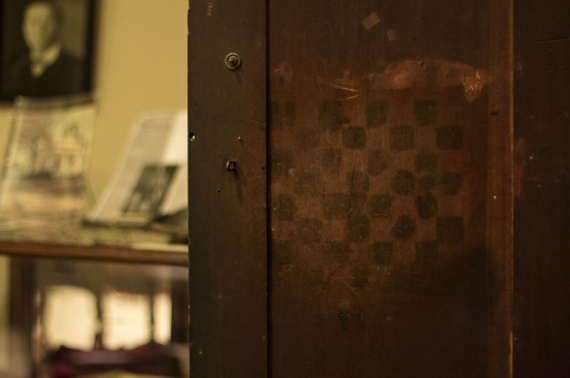
The door of an old cabinet, removed and used as a checkerboard by Union soldiers occupying the church during the Civil War.
In 1864, during the Civil War, Roswell was occupied by Union troops who used the church as a hospital. Memorabilia of those days still remain. The door of an old cabinet, removed by Union soldiers who painted a checkerboard on it, can be seen in the History Room. Also there is the original church Bible, with the words, “Run, John run, the Yanks will get you,” scribbled on the frontispiece by a soldier.
The original church communion silver, hidden during the war, is displayed on the table at each communion service. The Reverend and Mrs. Pratt, refusing to leave their home and the church, occupied the upstairs of their home while Union officers were quartered below.
When the war ended, the people of Roswell returned to bury their dead and to pick up the pieces of their shattered lives. Most families lost sons, husbands, and fathers. The town struggled to survive the aftermath of the terrible ordeal.
The first burial ground, Founders’ Cemetery, on Vickery Creek, was closed in 1860. Later, all who were members of the Presbyterian Church were buried in the new cemetery on the church property. A stream, with a small bridge, at the foot of the hill separated the church grounds from the cemetery. Though the highway later divided the property, it remained the church cemetery, and the town soon grew far beyond.
The Later Years
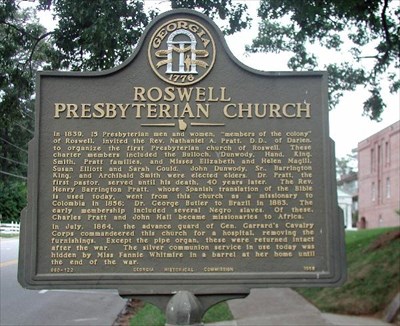
Georgia Historical Marker in front of the Historic Sanctuary
From 1926 until 1939, the church was unable to support a full-time pastor. During those years, Columbia Theological Seminary supplied student pastors to the church. Since then, the church has been served by the following ordained pastors: Richard Potter (1939-1941), Richard Orme Flinn, D.D. (1941-1948), William E. Garrison (1948-1953), William Crowe Jr., D.D. (1954-1964), Cyrus S. Mallard Jr. (1965-1993), and Dr. E. Lane Alderman Jr. (1994-2015), Mark Brewer (2015-2016), Jeff Meyers (2017 - present).
The never-ending story of the church goes on—the prayers, the sacrifices, the concern, the loving kindness, and the outreach in God’s name. This is the history of the Roswell Presbyterian Church, His story, the ageless story of God’s will at work among His people.

